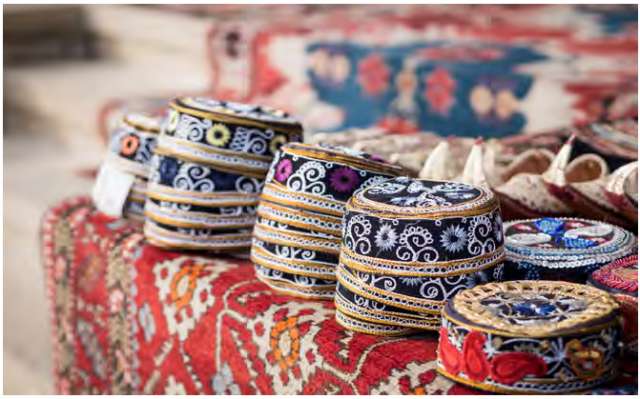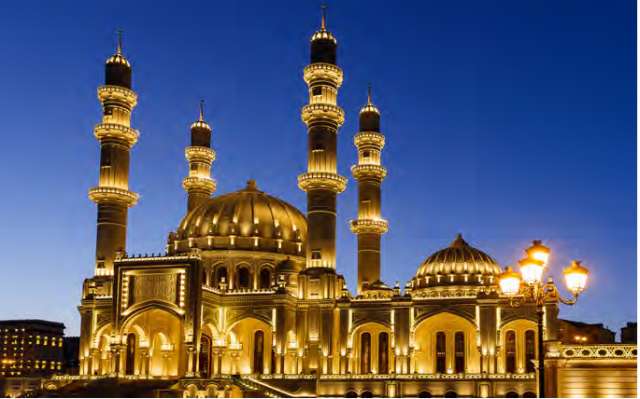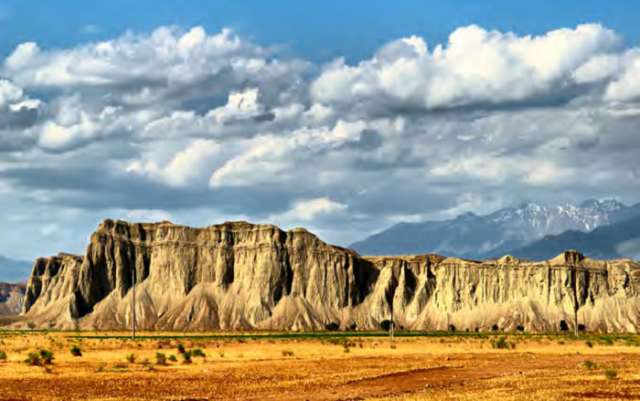Late in the evening your plane lands at the airport in Baku. You will be warmly welcomed at the airport by our guide, who will stand by you during the whole your trip. Our bus will take you to the hotel where you can relax after the flight.
Day 2
Our acquaintance with Azerbaijan starts with its capital. The centuries-old quarters merge with totally modern parts of the city. It is place where rich history mingles with magnificent present. For the western visitor Baku will be a sensational city. The sights line up one after another, all streets are full of fashionable boutiques and cozy pubs and incredibly nice and helpful people create very pleasant atmosphere around. Moreover, large parks, smartly renovated old town and illuminated fountains help to create unforgettable image of Baku. The contrasts here have always been impressive but now the city is also a real exposure of the contemporary imposing architecture.
Firstly, we visit the legendary Zoroastrian Maiden Tower of the 5th c. Then we walk to the old bazaar. The entire old town is a UNESCO World Heritage Site and during our city tour we visit the oldest Multani Caravanserai, the Haj Banu-Hammam from the 15th c., the Juma Mosque (Friday Mosque), which housed the carpet museum in the Soviet times, the Beglyar Mosque, Abu Bakr Mosque with the tower from the 11th c., the Taza Pir Mosque as well as the Shirvan Palace and the Jewish district. You will be also impressed by the modern district with the three Flame Towers overlooking the city. They look as if they have been thrown from heavens into the city by some fabulous giants.

Day 3
On this day we take a trip to the peninsula of Apsheron. The peninsula is a known oil extraction area. The capital Baku is located on its western part. Apsheron is not only rich in salt lakes, mineral sources and mud volcanoes but it is also famous for numerous historical sites. In Surachani we visit the Zoroastrian fire temple. Our guide will highlight the main principles of this monotheistic religion and its dissemination in today’s Azerbaijan. In Mardakan we will get a chance to see the medieval fortress towers and the Tuba Shahi Mosque from the 14thc. A walk through the local arboretum will refresh and relax us and exotic plants from around the world provide a great background for taking photos. Next comes a trip to Ramana with its majestic tower. In strongly influenced by Islam Nardaran, we visit probably the most magnificent mosque in the country. In the village of Qala we see the remains of caravanserais, mosques and bath houses. Finally, we set off to the Burning Mountain in Digah.
Looking at the flaming rock, you may assume that the rich oil and gas deposits have led to fairly irresponsible use of the raw materials. In the evening we come back to Baku and visit a folk song-and-dance concert.
Day 4
This day is one more opportunity for us to assure ourselves in ethnographic and religious gorgeousness of this country. Our first stop is Maraza (Gobustan) – the place of former Molokan (milkmen) settlements. Molokans were a religious community that split from Russian Orthodox Church. According to their tradition they drink milk on holidays. We learn much more about their rituals and traditions from our guide. In Maraza we see a century-old Muslim cemetery and two-story white cave mausoleum which was built in honor of Diri Baba and which is nowadays inhabited by hermit.
We leave this steppe area and approach the former capital of Shirvan Khanate. Previously the town Shamakhi was a considerable craft and trade center. The city has long literary tradition and it is the place where famous Azerbaijani poet Nasim was born. That is why the city has become a symbol of Azerbaijani identity. Here we also visit Juma Mosque and the impressive seven mausoleums situated on the cemetery.
Passing steep mountains and canyons we arrive in the village of Lahich – a traditional centre of copper forged art connoisseurs. Owing to the Ismaili minority this tradition has been preserved. Practically in every street you can find a copper smithy and the whole town looks like a gift shop. In the evening we reach Qabala and stay there overnight.

Day 5
Early in the morning we take a walk through the downtown Qabala. Besides the beautiful mosques we also see the Imam-Baba Mausoleum of the 18th century and the fortress tower from the 9th c. We leave the city and admire a breathtaking view of the surrounding mountains, including the highest mountain in the area Bazardüzü (4466 m). Just in front of it you will see the “problem child” of the local (and not only) authorities – operated by Russians radar station, used to monitor satellites and rockets. The ruins of the ancient city of Qabala from the 4th c. BC lie 15 km away. Up to the 12th c. before Persian conquest, Qabala used to be a capital of the ancient kingdom of Albania. On a 25-acre site were excavated city wall with gates, guard pillars, furnaces and cemeteries.
In the nearby village Nij we explore the former center of the Albanian Christian church. In addition, the village is the original settlement of ancient Udi people, who over the last centuries have merged with the Azerbaijani people. The details of their beliefs, history and language you will learn on site. On our way to Shaki, the former center of silk production, we also pay a visit to an imposing synagogue of the Mountain Jews in Oguz. In Shaki we will stay in a old caravansarei. In the garden restaurant we will be served a dinner in a national style.
Day 6
Our next destination is the former center of silk production Sheki. As the Silk Road was intimately connected with the trade, first of all we pay a visit to a trading square, that is local, oriental-style bazaar, which is a highlight among travelers. The most popular here are the spices, which turn out to be quite unusual for the western taste. Do not forget to try halva, made here according to traditional recipes. Then, we visit the legendary Palace of Shaki Khans built in the end of the 18th c. It was built in the Ottoman style and is distinguished by its stunning frescoes and stained glass windows. We finish our excursion in Shaki in the local silk factory. In the late afternoon we arrive in the mountain village of Kish where is situated the legendary oldest church in the Caucasus.
In the late afternoon we reach Mingachevir – an ancient city situated on the identically named artificial sea and stay here for two nights.
Day 7
The city is closely connected with the name of the Azerbaijani poet of the 12th-13th c. Nizami. We will see the grave of the poet, his monument and learn about the importance of his works which have deeply influenced the world culture. In order to honor this prominent writer, UNESCO declared 1991 the Year of Nizami. Like all former intellectuals, Nizami was well versed in mathematics, astronomy, medicine, law, history, philosophy, music and the other arts. On our city tour we also see Ibrahim Jafarov’s house made of bottles. Jafarov has made his house of almost 50 000 bottles and dedicated the construction of it to the memory of his brother, who was lost during World War II.
At the foot of the small Caucasus we find Gäygöl, the first German settlement in the region, established here in 1819 by the German farmers, also known as Helenendorf. Not far away we find a handful of original German settlements. When, at the beginning of the 19th c. more than 500 families of landless peasants left Württemberg to escape poverty and political despotism, they found shelter in generous Azerbaijan. The establishment of Soviet power in Azerbaijan was the beginning of a tragic period. Private property, land ownership and businesses of the colonists were expropriated without compensation. Nevertheless, before the outbreak of World War II there were still 20,000 German living in Azerbaijan. You will get much more information about their fate on the very site. In Helenendorf we visit St. Johannes’ Church and an old German cemetery.
In the evening we come back to Mingachevir.
Day 8
In the morning we explore thoroughly the city that has given us accommodation for two nights. Throughout its history, Mingachevir has several times become a real place of pilgrimage for archaeologists. It is no coincidence that in the ancient chronicles Mingachevir was several times mentioned as an important cultural and commercial center. The recent history of the city begins with the establishment of a hydroelectric power plant in the middle of the 20th c. Here we will visit the most famous attraction in the area – archaeological excavations of prehistoric settlement Sudagylan.
After an hour drive we arrive in Naftalan. Here you can really swim in the oil – Nafltalan is a fashionable resort with an annual pilgrimage of thousands of patients which seek here relief bathing in oil. But who considers such dip suspicious, can simply take a walk by the lake. We continue along the Kura River, pass salt lakes and endless cotton fields and in the evening come to the capital of this in the meanwhile must have become for you very familiar.
Day 9
On this day we move southwards to the regions with several oil fields that actually secure all the luxury of the capital. The morning drive along the coast of the Caspian Sea resembles a journey through the industrial area. Notable industrial landscapes of an abandoned oil fields, such as that of Bibi-Heybet oil field, alternate with recently launched ones. Right on the coast we see the grave of the Polish engineer Pawel Potocki. Having significantly contributed to the development of the oil field, the Polish scientist, inventor of the so-called sand pump was and still remains a respected person in Azerbaijan.
Afterwards, in the semi-desert at Qobustan we will marvel thousands-of-years-old Stone-Age rock drawings. In 2007 these petroglyphs were declared by UNESCO a World Heritage Site. In Elat we see one more landscape peculiarity – mud volcanoes. In the late afternoon you can en joy your free time. Our tour guide will happily recommend possible activities. If you are in a mood for a concert, do not miss your chance to hear traditional Azerbaijani music, where among other things, you can hear the famous mugham (a genre of music), which was added to the UNESCO List of the Intangible Cultural Heritage of Humanity.
Day 10
Today we leave the peninsula and head for Quba, the main town in northeastern Azerbaijan. Traditionally, Quba is most famous for carpet making and apple growing. We take a walk through the city center, see the beautiful mosques, a fort and an old bathing house (the old Hammam). Then we visit a carpet factory. After lunch we explore the suburb of Quba – Krasnaya Sloboda or Qasaba – known as the world’s only settlement with a compact settlement of the Mountain Jews, whose community comprises only about 100,000 people worldwide. We meet a representative of this Jewish community, who will make us acquainted with the history, origin and current state of affairs of these people. We also visit the local synagogue. In the evening we come back to Baku.
Day 11
Half of the day is devoted for leisure. You can still catch up on everything that you have missed during the other days. Baku with its shops and boutiques is the ideal place for shopping. In the morning, you can visit the local market and feel the charm of oriental bazaar or just rest in one of the many beautiful manicured parks. In the afternoon, we meet again and start our way towards the airport.
We believe that you will enjoy your time in Azerbaijan, discovering its rich culture, traditions and nature. Thus, we hope to welcome you in this hospitable country again and again.
Included:
• 10 x nights: 6 x Baku, 1 x Qabala, 1 x Sheki, 2 x Mingachevir.
• Local English-speaking guide or other languages on request.
• Transfers by modern coach.
• Catering: HB.
• English-guided (and other languages) tours: Baku, Schamachi, Qabala, Sheki,Mingacevir,
Naftalan, Quba; round trip in Ganja.
• Entrance+Guided Tour: all sacral buildings according to the program, Zoroastrian Maiden’s
Tower, Zoroastrian Fire Temple, arboretum in Mädäkän, Khan-Summer Palace, historic
museum, visit to the silk factory, visit to the carpet factory.
Extras:
Multani Caravanserai, the Haj Banu-Hamman, the Juma Mosque (Friday Mosque), the Beglyar Mosque, Abu Bakr Mosque, the Tezepir Mosque, the Shirvan palace,the Tuba Schahi Mosque, Ramana castle, folk music concert, Caravanserai, Mosques and terms in Qala, Burning Mountain in Digah, visiting of Molokan (milkmen) community,Muslim cemetery, mausoleum in the honor of Diri Baba, Juma Mosque and mausoleums on the cemetery in Shamakhi, vistit the village of craftsmen in Lahich village, Imam-Baba Mausoleum in Qabala, ancient city of Qabala; the former center of Albanian Christian church in Nij; synagogue in Oguz, bazaar in Shakthe, bottle house in Ganja, St. John’s Church and the old German cemetery in Helenendorf; visit of excavations of prehistoric settlement in Sudagylan; visit the grave of Pavel Potocki, petroglyphs in Qobustan, mud volcanoes in Elat, meeting with the representatives of the mountain Jewish community.

















































Innes Walker 22:58 08 March 2017
I've heard a terrible ledend about Maiden Tower. Father wanted to marry his own daughter and she, in order to avoid this marriage, jumped from the top of the tower committing suicide. Is it true?